ARCHITECTURE PORTFOLIO
Seleted works 2017-2022
YAN YUTIAN
Hunan University
Bachelor of Architecture
Applying for Architecture and Urban Design
Personal Code 10959381
tian097yan@outlook.com
YAN YUTIAN
Suzhou, Jiangsu Province, China (Mainland)
Date of Birth: 9th December, 1997 Age: 25
E-mail: tian097yan@outlook.com Phone: +86 18118119006
EDUCATION
Hunan Unversity (HNU), Changsha, China
School of Architecture and Planning, Bachelor of Architecture
PROFESSIONAL EXPERIENCE
PT Architectural Design & Consultant Co., Ltd, Shanghai, China
Designer
+ Conceptual Design of Urban Renewal Project of Xinzha Road and Xiamen Road Plot; Participate in schematic design, preliminary study, modeling & drafting and drawings
+ Wuhan Central Cloud City Project of Wuhan Urban Construction Group; Participate in schematic design, preliminary study, modeling & drafting and drawings
+ Yanlord Guangdong Zhongshan Changshapu Village Temporary Office and Teahouse Project (Individual); (INDIVIDUAL) Preliminary study, concept, scheme design, modeling & drafting and drawings
+ Yanlord Zhuhai High-tech Zone East Coast Liushi Mountain Renewal Project. Participate in modeling, drawings and construction phase
PT Architectural Design & Consultant Co., Ltd, Shanghai, China
Intern
+ Yanlord Zhuhai High-tech Zone East Coast Liushi Mountain Renewal Project. Participated in schematic design, preliminary study and modeling & drafting
COMPETITION & EXHIBITION
Team Project: EASE (A construction built by polypropylene hollow sheets)
Role: Team Member, Designing and Constructing
The First 'DREAMERS' Construction Festival for University Students of Hunan Province
2017 Tongji University International Construction Festival First Prize
Third Prize Team Project: EASE (A construction built by polypropylene hollow sheets)
Role: Team Member, Designing and Constructing
ACTIVITY
Logo Design Competition for The Science Base of The Architectural Society of China
Role: Individual Work
Third Prize
HNU FRESHER'S Cup Football Championship
Champion
Role: Team Main Player / Defender
SKILLS SUMMARY
Chinese (Native), English (Proficient, CEFR Level: C1, IELTS: 7.0), Cantonese (Beginner)
AutoCAD, Adobe Suite, Sketchup, Rhinoceros, Grasshopper, Enscape, Vray, D5 Render
09. 2016 - 07. 2021
06. 2017 07. 2017
11. 2016 04. 2020 Shanghai
Shanghai
Architectural
Architectural
07. 2021 - 04. 2022 07. 2020 - 09. 2020
+ SOFTWARE + LANGUAGE
Contents 01 URBAN AGRICULTURE RENASCENE 02 OBSERVATION TOWER AT ZSPD 03 FOUR QUADRANTS ARTIST COMPLEX 04 ANOTHER EXHIBITION 05 PROFESSIONAL WORKS 06 OTHER WORKS A Civil - Friendly Urban Agriculture Institution A Spatial Experiment of Combinition of Cafe and Exhibition Consist of 4 professional projects during work experience A Observation Tower Built For Aviation Enthusiast Design students centre + Typography Studio + Gallery + Office
A Civil - Friendly Urban Agriculture Institution 01
URBAN AGRICULTURE RENASCENE
[Location]
[Date of Design]
[Label] [Category]
[Instructor]
Shanghai, China October, 2022
Individual Work / Independent Study Public Building

JIANG Boyuan from Studio Alpha
Since China's reform and opening up in 1978, China's major cities have undergone rapid urbanisation and during such rapid urbanisation, traditional agricultural is leaving us. Whereas 20 years ago farming life and the rural land were an essential and everyday part of residents' lives, in today's high-rise cities, agricultural civilisations and techniques are gradually being forgotten by city dwellers. In this project, I try to re-implant agricultural culture and techniques into the modern city, so that today's city dwellers can once again feel and experience the advanced agricultural techniques and farming culture of today.

CURRENT SITE CONDITION
The site is situated beside the Huangpu River in Pudong New District, Shanghai, China, which used to be traditional farmlands but has been transformed into commercial land and open urban green space during the rapid urbanisation process.

LOST OF AGRICULTURE

Shanghai has undergone a rapid urbanisation process since the reform and opening up, transforming the farmland into a modern city
The data above shows the urbanisation rate and the proportion of the rural population in Shanghai after 1978, which shows that the urbanisation rate has risen from 58.7% in 1978 to a staggering 95% in 2022, and the rural population has fallen from 91% to merely 12% today.
The following diagram shows the subjective relationship between rural and urban farming ,which shows that in rural farming there is a strong connection between people and agriculture, however, the existing urban farming system loses its connection with the city dwellers.





6
150m 300m 450m 600m 750m 900m 150m 0m 300m 450m 600m 750m 900m 1050m 150m 300m 450m 600m 750m 900m
RURAL AGRICULTURE MODE URBAN AGRICULTURE MODE
Before 1978 Traditional Agriculture Reform and Opening Up 58.7% 47.7% 1978 1973 Urbanization Rate of Shanghai Proportion of Rural Citizens 1983 1988 1993 1998 2003 2008 2013 2022 62.5% 66.5% 69.0% 73.0% 77.6% 81.6% 83.9% 95.4% 87.1% 71.0% 70.0% 65.4% 47.7% 43.7% 30.0% 12.0% 91.5% 95.4% Pudong Opening Up Completely a Modern City 1978 1992 2022 N Farmers Cultivation Observation Interaction Learning Rural Citizens Traditional Fields Cultivation Scientific Study Not Connected Not Connected Urban Citizens Agriculture Specilist Urban Vertical Farming 1
3 2 4 2
1 Xian Art Centre 2 Shanghai Expo District 3 Qiantan Commercial Area 4 Huangpu River
RECONNECTING THE PUBLIC TO AGRICULTURE
Imagine a place in the city where advanced urban agriculture is produced and tested, and where city dwellers can come to experience and observe agricultural production that they haven't experienced for a long time




[Conceptual Collage]

DESIGN STRATEGY
7
Four steps bringing people back to agriculture
Inserting greenhouse for vertical farming
Final building volumn Set public activity space near the loop 01 02 04 03
Looping a ramp around the greenhouse

8
AXONOMETRIC EXPLOSION DIAGRAM



9 ROOF PLAN
FLOOR
TYPICAL
PLAN GROUND FLOOR PLAN
1. indoor rice experimental field
2. roof open greenhouse
3. camping platform
4. platform 5. parking
6. art gallery
1. indoor wheat /maize experimental field
2. vegetable cultivation
3. lecture hall / greenland
4. laboratory / greenland
5. photography studio
6. painting room
1. vegetable cultivation
2. packaging lines
3. cafe & restaurant
4. supermarket
1-1 1-1 N 0 8m 20m A-A A-A 1-1 1-1 N 0 8m 20m A-A A-A 1-1 1-1 N 0 8m 20m A-A A-A 1 1 1 2 2 2 3 3 3 4 4 4 5 5 6 6 5
5. staff platform
A
FRIENDLY INTERFACE TOWARDS HUANGPU RIVER
I have tried to create a civil-friendly image of the building by designing a clean and neat façade and trying to make the inner glass volume - the urban agricultural space, and the outer ramp - the civil activity space, have an attractive feeling through the façade


DIVERSE INDOOR PLANTING SPACES AND HARMONIOUS INDOOR-OUTDOOR RELATIONSHIPS
indoor agricultural space features rice experimental fields, wheat experimental fields, maize experimental fields and vegetable cultivation areas, surrounded by a gradual ramp that allows for an interesting dialogue with indoor agriculture.
10
The


11 WEST ELEVATION PERSPECTIVE 1-1 SECTION 0 2m 10m
0 2m 5m
BUILDING OPERATING SYSTEMS AND SUSTAINABLE DESIGN
DIRECT SOLAR POWER INPUT ≈10% ≈20%
ELECTRICITY TRANSFERRED FROM SOAR POWER
ROOF CAMPING PARKING
GREENLAND
STUDIO
GREENLAND
The building uses mainly city electricity, but also uses environmentally friendly energy to achieve a sustainable design, for example, the transparent façade replaces part of the electricity supply with direct sunlight, while solar panels further save the electricity used by the building
DRAWING ROOM
WATER SOLAR POWER RAINWATER SOLAR CELLS
SUPERMARKET

LECTURE HALL
≈20% ≈80% ≈70%
RAINWATER COLLECTION LABORATORY VISITOR ENTRANCE CAFE
WASTE WATER TREATMENT
URBAN WATER INPUT
AGRICULTURAL RAW MATERIALS URBAN WATER SUPPLY
REUSED-WATER INPUT URBAN ELECTRICITY INPUT URBAN ELECTRICITY SUPPLY AGRICULTURAL PRODUCTS
STORAGE

12
A-A Short Section POWER ENGAGEMENT
The water supply is an important part of the design of the urban vertical farming. Water supply from the city is the main source and the building is equipped with a water recycling facility and waste water treatment device, and this part of the design can achieve the expected 20% water saving. RESOURCR ENGAGEMENT


13
A space for citizen activities and observation of the workings of urban agriculture, and the gallery based on agricultural art enhances the experience of urban agriculture
OUTDOOR RAMP AND GALLERY
Indoor rice test field space with a central void for vertical access to the indoor farm and good natural lighting, which is a staff-only space in this project
INDOOR RICE EXPERIMENTAL FIELD
TOURISTS' BROCHURE
As an urban agricultural institution hypothetical tourists' brochure


14
FOR THIS PROJECT

institution open to the public, this is a for visitors to the institution

15
BROCHURE
STRUCTURE INTERVENTION: STEEL STRUCTURE
This is the detail of part of the main steel structure of the building, the agricultural space and the outer ramp are connected by a steel structure and a reasonable overhang is used in the civic use space

16


17
A semi-open-air lecture hall for visiting citizens to learn about the development and current state of urban agriculture, a place where agricultural producers and citizens can interact
A rooftop open space where citizens can experience urban farming themselves, where professionals and citizens can interact
PUBLIC LECTURE HALL
ROOF OPEN GREENHOUSE
OBSERVATION TOWER AT ZSPD
An Observation Tower Built For Aviation Enthusiasts
[Location]
[Date of Design]
[Label]
[Category]
[Instructor]
Shanghai, China July, 2022
Individual Work / Independent Study Observation Tower
JIANG Boyuan from Studio Alpha
Airliners are more than just people's daily means of transport. The rigorous operational processes and beautiful aerodynamic shapes of modern airliners have given rise to a subculture group - aviation enthusiasts. They are obsessed with all things aeroplanes and often travel around airports on their own initiative to find suitable locations to photograph them. However, Chinese airports are often strictly regulated, and there is a shortage of locations for them to film and view.
In this project I tried to design a observation tower for this subculture group while taking the safety conditions and restrictions around the airport into account.

02

A SUB-CULTURE GROUP - AVIATION ENTHUSIAST WHO ARE THEM? WHY TO BUILD A TOWER?
SITE MAPPING AND RESTRICTIONS TO BE FOLLOWED


Analysis of the feasibility of building a viewing tower around the Pudong International

Poor Visibility
The terrain around the airport is complex and tends to create view blockage for aviation enthusiasts

Wheather Threat
Filming around airports usually takes a long time and the weather has to be taken into account in the open air

No Communication And Rest Space
The long hours of shooting leave aviation enthusiasts without a appropriate space to rest and communicate with each other
20
Site Map On Google Map App
0 N 200m 500m 1000m Greenland Current Airport District Construction Area Terminal Taxiway & Apron Point To Be Observed Current View Point Site Restriction Area Sea & Water Runway
Please note: some information about runways and taxiways are from Civil Aviation Administration of China (CAAC)
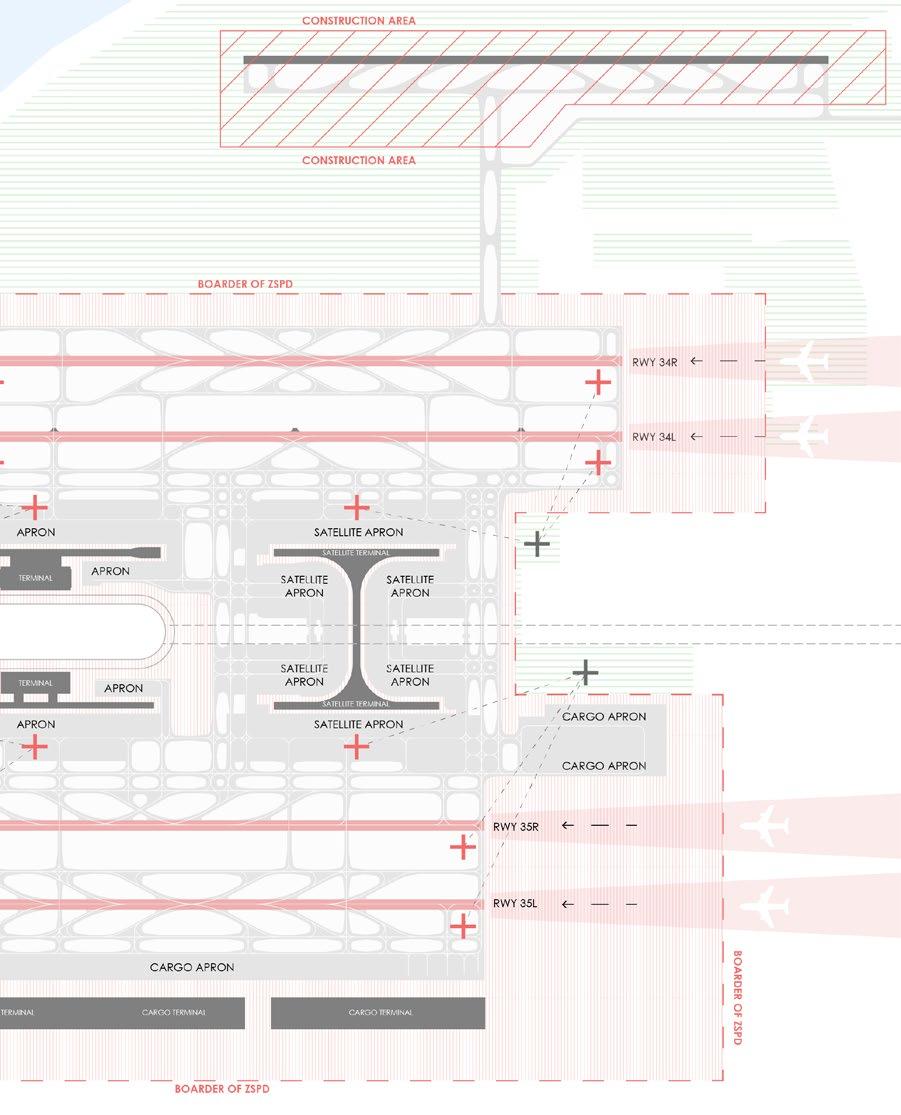
21
International Airport (ICAO: ZSPD)
ELEVATION PERSPECTIVE

22
The viewing platform and balcony in the lower area form the public space of this observation tower. This is an area designed for aviation enthusiasts and to view and relax and communicate.


23
AXONOMETRIC EXPLOSION DIAGRAM
1-1
Shanghai Pudong International Airport is a 4F airport with multiple runways and aprons, so having viewing platforms at different altitude levels and facing different directions allows for a variety of viewing experiences.

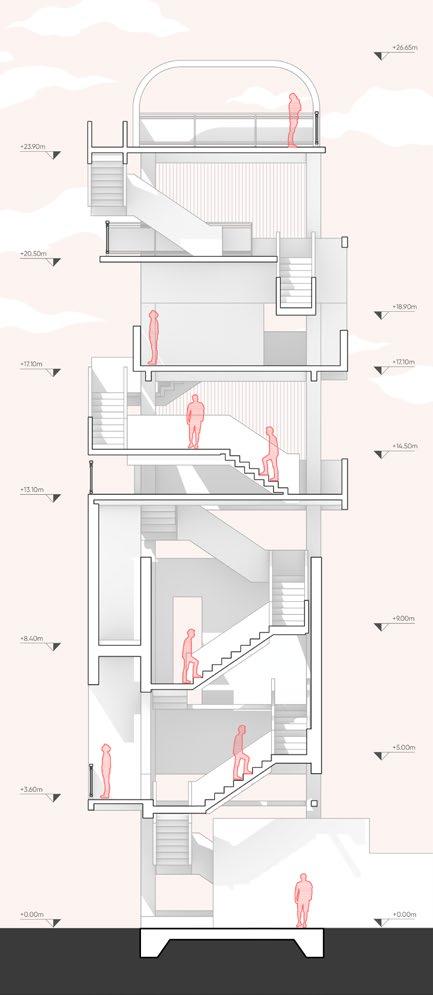
24
Viewing Platform Viewing Platform Viewing Platform Rooftop Viewing Platform Viewing Platform Viewing Platform Ground Balcony Ground 0 4000mm 2000 800 0 4000mm 2000 800
SECTION AND A-A SECTION
RENDERING OF VIEWING PLATFORM

25
The semi-arched viewing platform faces runway 17R and provides a clear view of the aircrafts' taking off and landing, from this platform it is also possible to photograph the terminal and apron in the distance with a telephoto lens.
Rooftop Viewing Platform Rest Area Balcony Ground
PERSPECTIVE FROM THE RUNWAY OF THE AIRPORT
In this project, I wanted the observation tower to be part of the landscape around the airport and to become a landmark for the facilities around Shanghai Pudong International Airport and a symbol of the group of aviation enthusiasts

26
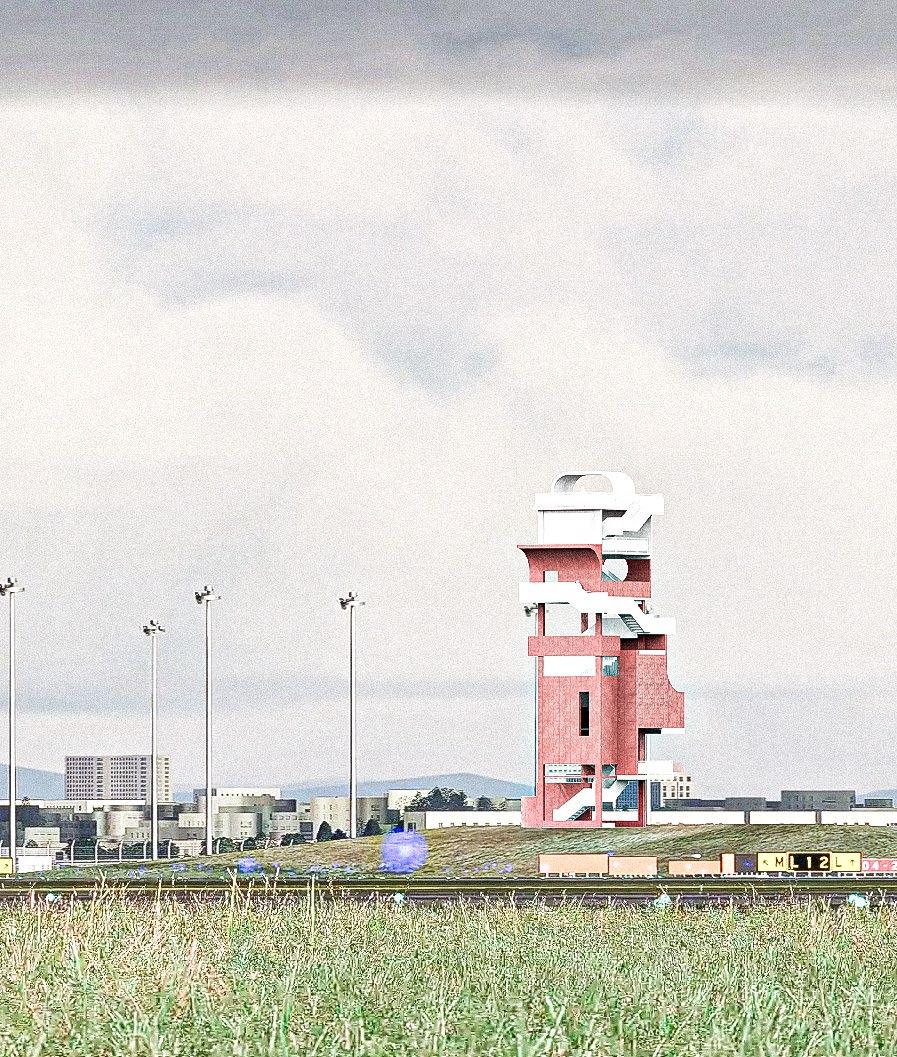
27
FOUR QUADRANTS ARTIST COMPLEX
Graphic design students centre + Typography Studio + Gallery + Office
[Location]
[Date of Design]
[Label]
[Category]

[Instructor]
Virtual Site
May, 2022
Individual Work / Independent Study Public Building
YANG Jie from Studio Alpha
In his book Dealing With Characters on graphic design, Zuozuo talks about four groups of people he has come across in his years of practice in relation to design and art, which are designers themselves, other students and design students, their clients and the public, and how they interant in the process of a design commission. Intersetingly, all the four groups have different characteristics and may have interaction with each other. In this project, I try to bring them together into an artist complex and make them generate interesting conversations.
03

CONCEPT SOURCE: FOUR POTENTIAL GROUPS


RELATIONSHIPS AMONG FOUR GROUPS




Four categories of people are distinguished according to whether they are engaged and whether they are professional. These four different groups of people all have relationships with each other and have different group characteristics

30
DESIGN CLIENTS TYPOGRAPHY DESIGNER THE PUBLIC DESIGN STUDENTS MIX
Dealing With Characters Author: Zuozuo - A famous book about graphic design and typography





31 GROUND FLOOR PLAN 01 01 01 01 04 02 02 03 03 04 05 06 07 08 02 02 03 03 04 05 06 07 08 04 05 01 Lobby 02 Reception 03 Archieve 04 Meeting Room 05 Office 06 Storage 07 Washroom 01 Cafe 02 Bar 03 Kitchen 04 Stairs 01 Lobby 02 Reception 03 Co-working area 04 Office 05 Presentation 06 Workshop 07 Print room 08 Washroom 01 Lobby 02 Reception 03 Discussion area 04 Workshop 05 Print room 06 Classroom 07 Typography practice 08 Washroom UNIT A FOR CLIENTS UNIT A FOR CLIENTS UNIT D FOR THE PUBLIC UNIT D FOR THE PUBLIC UNIT C FOR STUDENTS UNIT C FOR STUDENTS UNIT B FOR DESIGNER UNIT B FOR DESIGNER A - A A - A MAIN ENTRANCE CONNECTING CORRIDORS CONNECTING CORRIDORS OUTDOOR STAIRS CONNECTING CORRIDORS MAIN ENTRANCE MAIN ENTRANCE MAIN ENTRANCE 06 07 1 - 1 0 2m 5m 10m N
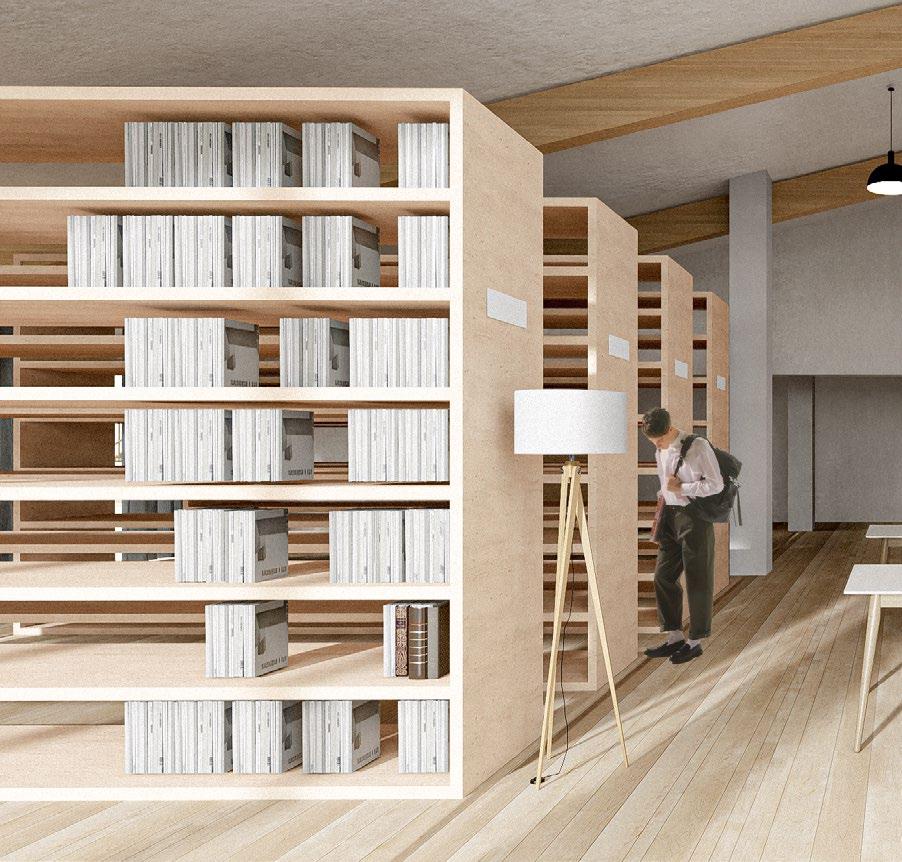


32 1. Library 2. Self-study area 3. 2F entrance 4. Stairs 5. Lecture Hall 6. Multi-function room 2F UNIT C PLAN 01 01 03 04 02 02 04 03 06 05 0 8m 20m N
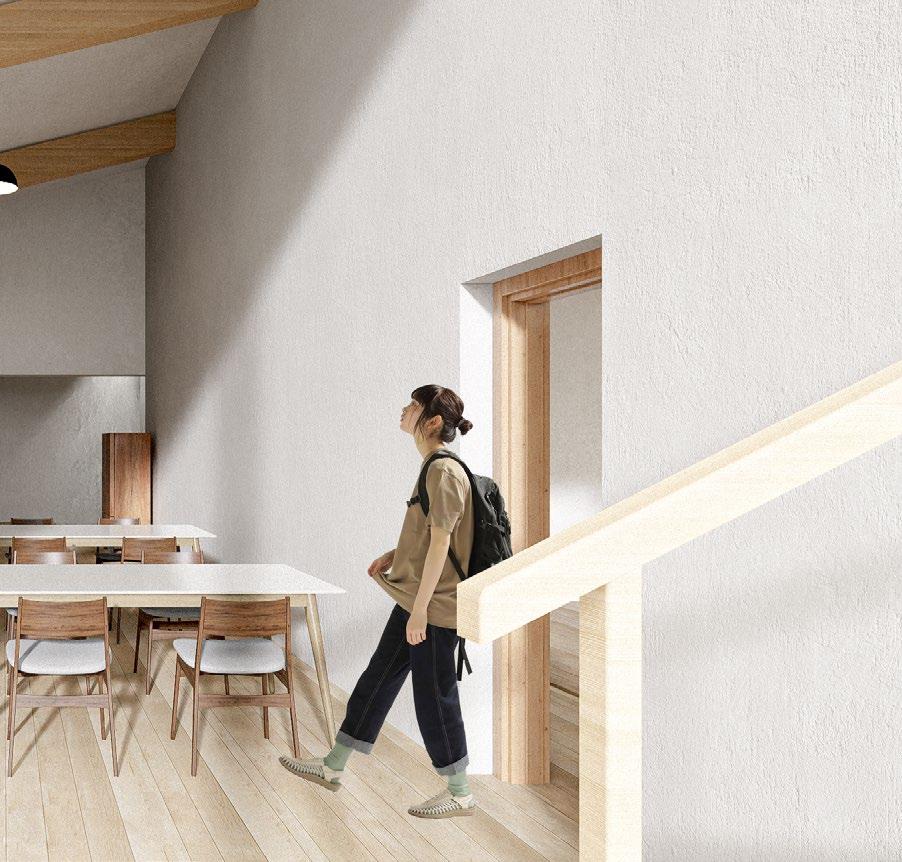
33
Interior Rendering: Library
1. Balcony
2. Roof
3. Stairs
4. Restroom
3F UNIT C PLAN
This part of the project is for the design students' area, which consists of a studying area on the ground floor for students to study graphic design, a discussion area and a working area, as well as a library and study room on the first floor and a common area on the second floor.
0 8m 20m N
UNIT C FOR GRAPHIC DESIGN STUDENTS
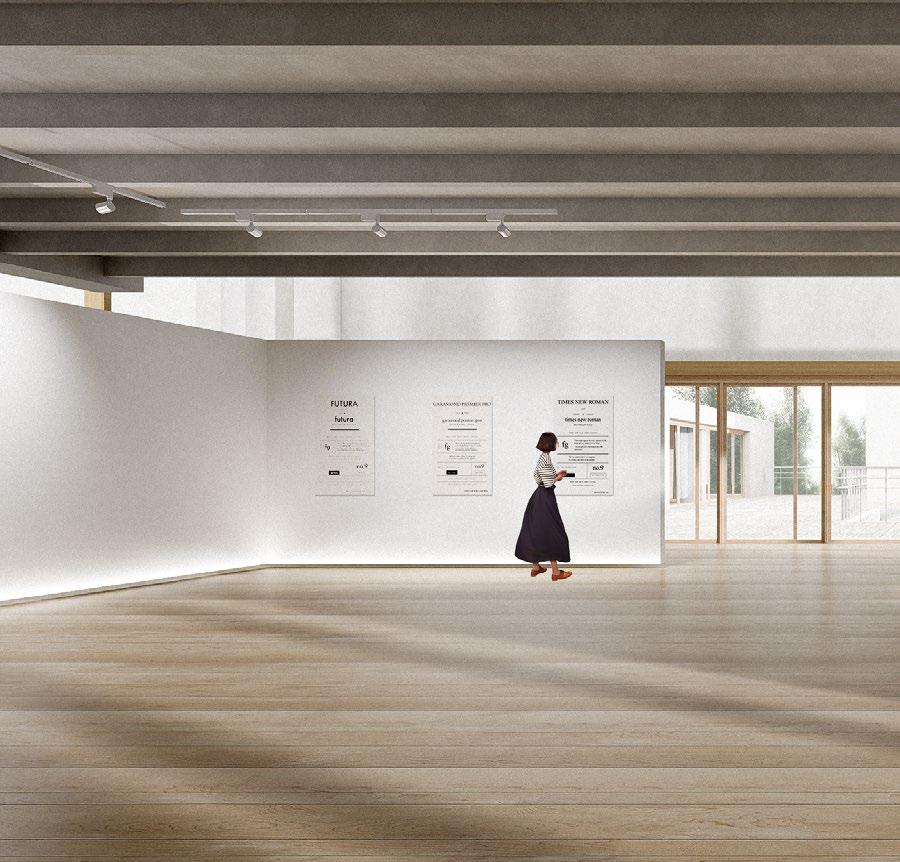


34 2F UNIT D PLAN 1. Gallery 2. Stairs (open) 3. Secondary entrance 4. Main entrance 5. Washroom 6. Storage 7. Stairs 01 01 02 03 04 05 06 02 03 04 05 06 07 N 0 8m 20m
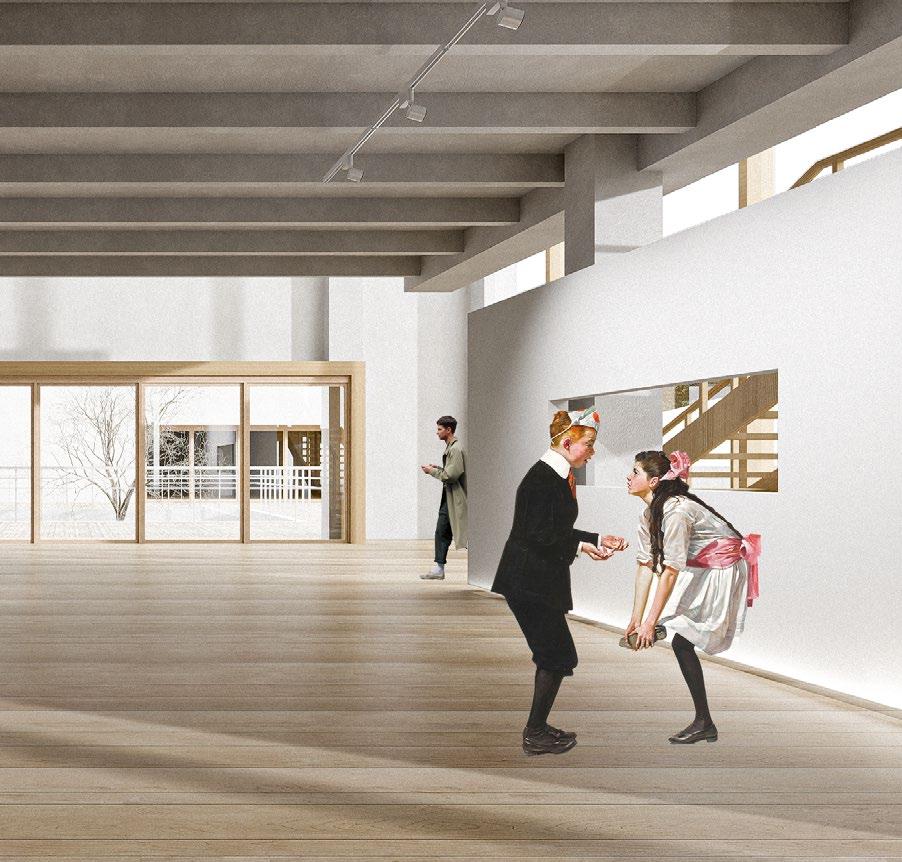
35 3F UNIT D PLAN
1. Lecture hall
2. Stairs(open)
3. Void
4. Washroom
5. Storage
6. Stairs
Interior Rendering: Typography Gallery
D
THE PUBLIC N 0 8m 20m
This part of the project is an area designed for the general public and contains a café on the ground floor, a typography gallery on the first floor and a large lecture hall on the second floor. Here the public can feel and experience the work of the designers.
UNIT
FOR
DETAIL SELECTED FROM 1-1 SECTION



36 Floor and Foundation Wall Roof & Ceiling - Cork Floor Finish d=20mm - Steel Batten - Thermal Insulation d=150mm - Bituminous Layer d=25mm - Protection Board d=25mm - Concrete Slab d=250mm -External cladding, d=40mm -Thermal Insulation d=150mm -Concrete slab d=120mm -Water-proof Layer d=20mm -Acoustic Insulation d=15mm -Interior Finish d=20mm -External cladding, d=40mm -Drainage -Steel Batten -Water-proof Layer d=20mm -Thermal Insulation d=150mm -Protection Board d=25mm -Acoustic Insulation d=15mm -Interior Finish d=20mm


37 Communication Platform A-A Section Perspective Public space on the first floor for all users Different working and learning scene in each unit
ANOTHER EXHIBITION
A Combination of Cafe and Exhibition

[Location]
[Course Info.]
[Refinement]
[Label]
[Category]
[Instructor]
Changsha, China
Interior Design and Principle, 1st Semester, 4th Year
April, 2022
Individual Work /Academic Project
Interior Design(Course Design)
HU Biao
This is a forth year interior design project (Interior Design and Principle) based on a real potential interior site on the first floor of the Hunan Provincial Art Museum in Changsha.In this course design, I had tried to integrate the traditional exhibition function of an art museum into a café that is located within the museum itself, based on a cylindrical spatial arrangement pattern, to create a space where people can rest and watch the exhibition at the same time.
04

The interior space of a traditional art museum is arranged in such a way that the exhibition space is completely separated from the café, and visitors follow the traditional logical rule of seeing the exhibitions in the exhibition hall and drinking coffee in the café. But I believe that the combination of the two functions will produce interesting spatial forms
CURRENT SITE LAYOUT
This is a course design based on a real project and site located in the south-eastern corner of the first floor in the Hunan Provincial Art Museum in Changsha, Hunan Province.


The entire interior has a rough L-shape, with a small depth of space and a large number of columns on the wall near the south side.
We were asked to design a cafe for the newly built provincial art museum for people visiting the exhibition hall, with the possibility of inserting other interesting functions such as exhibitions, retailing, etc. as required.

COMBINITION OF TWO SPACE


It'll be good to have a cup of coffee while watching a exhibition!

40
I'm feeling tired, Where is the cafe?
Scene 1: In the Exhibition Hall
Scene 2: In the Cafe
+
Current Exhibition
Current Cafe
Cafe + Exhibition
ADOPTED LAYOUT FOR INSERTING NEW SPACE
There are several typical forms of spatial design for museums, the main ones being Comb Type, Inner Sanctum, Given Route and Hero Object. I set a few filters to choose the appropirate type, which is the number of entrances, modularity and whether it is blocking visually


COMBINATION PATTERNS OF BOTH SPACE






In the long and narrow space I have tried to explore the possible combinations of cylindrical spaces, first forming irregular polygonal fills in the plane, then forming inner tangent circles within each polygon, and finally reducing this inner tangent circle by a certain proportion to create a space that can be used by visitors.

41
Functions Required Exhibition Exhibition Possible Space for Cafe Possible Space for Cafe
One
Exhibition patterns are on the
while
in the middle All the circles have a similar size while there is still some small ones There are three big circles and exhibition patterns appearing nearby Single Core Multiple Core Average Size Linear Pattern 1 Pattern 2 Pattern 3 Pattern 4 Pattern 5
Seperated
Each side is occupied by only one of the two patterns
biggest circle in the middle and exhibition patterns appear around
side
others
No Blocking Modularity Double Entrances Random Array Blocking No Modularity Single Entrance Inner Sanctum Comb Double Entrances Modularity Blocking No Blocking No Modularity Single Entrance Hero Object EXHIBITION EXHIBITION SINGLE SEAT PLANT MODULE THE BAR THEMULTI-FU NCTIONAREA SEAT 1 4x SUPPORTING MODULE SEAT 2 4x SEAT 3 4x WASHROOM SEAT 4 2x SEAT 5 2x EXHIBITION EXHIBITION EXHIBITION EXHIBITION EXHIBITION 1000mm

42 01 The Bar 02 Activity Area 03 Seat Module I 04 Seat Module II 05 Seat Module III 06 Exhibition Module 07 Support Module 08 The Main Entrance 09 The Secondary Entrance 10 Out - Door Platform 11 Elevator 12 Stairs 13 Washroom 10
N 0 1m 2m 5m 01 02 09 09 03 06 04 I III II 07 05 11 12 13 13 08
INTERIOR LAYOUT



43 INTERIOR RENDERING
I. The Bar Area
III. Lounge Box and Exhibition Module
II. The Giant Stairs in Activity Area










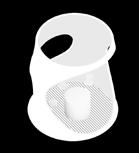


44 TYPOLOGY STUDIES Exhibition Sitting Area Service Exhibition Module I Φ = 1500 mm, H = 3300mm Support Module Φ = 3500 mm, H = 3900mm Bar Module Φ = 8000 mm, H = 3600mm Activity Module Φ = 8000 mm, H = 3600mm Potted Plant Module Φ = 900 mm, H = 500mm Single Seat Module Φ = 900 mm, H = 500mm Seat Module Φ = 3500 mm, H = 3900mm Seat Module Φ = 3500 mm, H = 3900mm Seat Module Φ = 3500 mm, H = 3900mm Exhibition Module II Φ = 2600 mm, H = 3600mm Seat Module Φ = 2600 mm, H = 3600mm Washroom Module Φ = 2600 mm, H = 3600mm 08
Twelve different types of unit modules have been placed throughout the cafe space to meet the 12 different functional modes required in the design and use process. All the modules adopt a similar formal logic, by giving them different sizes and heights, and by rotating them at different angles in combination with openings, they create interesting interactions with people, resulting in a regular and staggered interior space.

45 01 02 03 05 04 06 09 10 11 12 13 13 07 AXONOMETRIC DRAWING
01 The Bar 02 Activity Area 03 Seat Module I 04 Seat Module II 05 Seat Module III 06 Exhibition Module 07 Support Module 08 The Main Entrance 09 The Secondary Entrance 10 Out - Door Platform 11 Elevator 12 Stairs 13 Washroom
STRUCTURE INTERVENTION
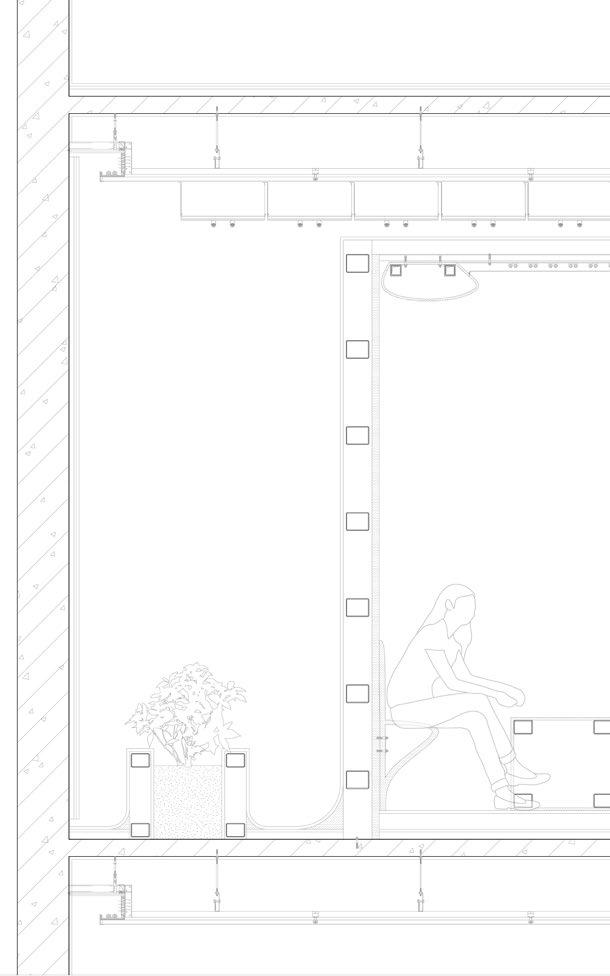
In addition, the choice of interior materials has been made by using a rough concrete material in line with the floor on the outer surface of the modules and a lighter coloured polished cherry wood grain material on the inside. In addition, brushed stainless steel panels are used for the ceiling and both walls to create an interesting space with a reflective effect.
Stainless Steel Ceiling

Spolights
Brushed Stainless Steel Panel
Strip Lighting
Rough Cement Layer
Light-Gauge Steel
Cherry Wood Grain Material
Culture Soil
46
Detail Section ( Selected from A-A Section)

47
Rendering - A Indicated Route Among Cylinders





50
OTHER WORK
Flash Shop Design
Landscape Design
Hand-made Model
Logo Design Competition for The Science Base of The Architectural Society of China
Summer Workshop 2020 (Team Work)
Course Work
Case Study Model of Chicago House by Tadao Ando Comprtition / Third Prize / Individual Work
2017 Tongji University International Construction Festival
Competition / Teamwork / Third Prize
Instructor: QI Jing from HNU
Team Member: CHEN Song, LIU Siqi, Yan Yutian, PAN Deshen, LI Xinyue, ZHOU Zehui
2017 Tongji University International Construction Festival



Competition / Teamwork / Third Prize

Instructor: QI Jing from HNU
Team Member: CHEN Song, LIU Siqi, Yan Yutian, PAN Deshen, LI Xinyue, ZHOU Zehui
51
Photography New and Old
Photography Angels and Skyscrapers Shot at Lujiazui, Shanghai Shot at Lujiazui, Shanghai


















































































































